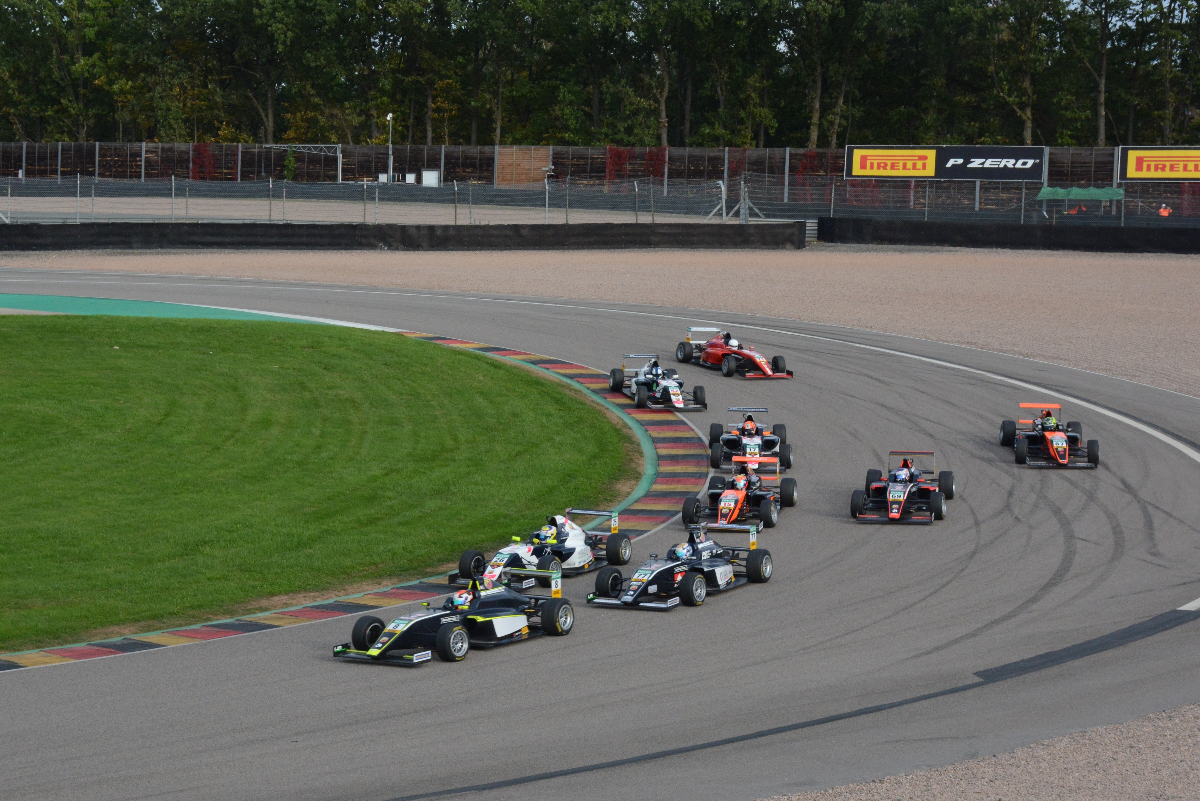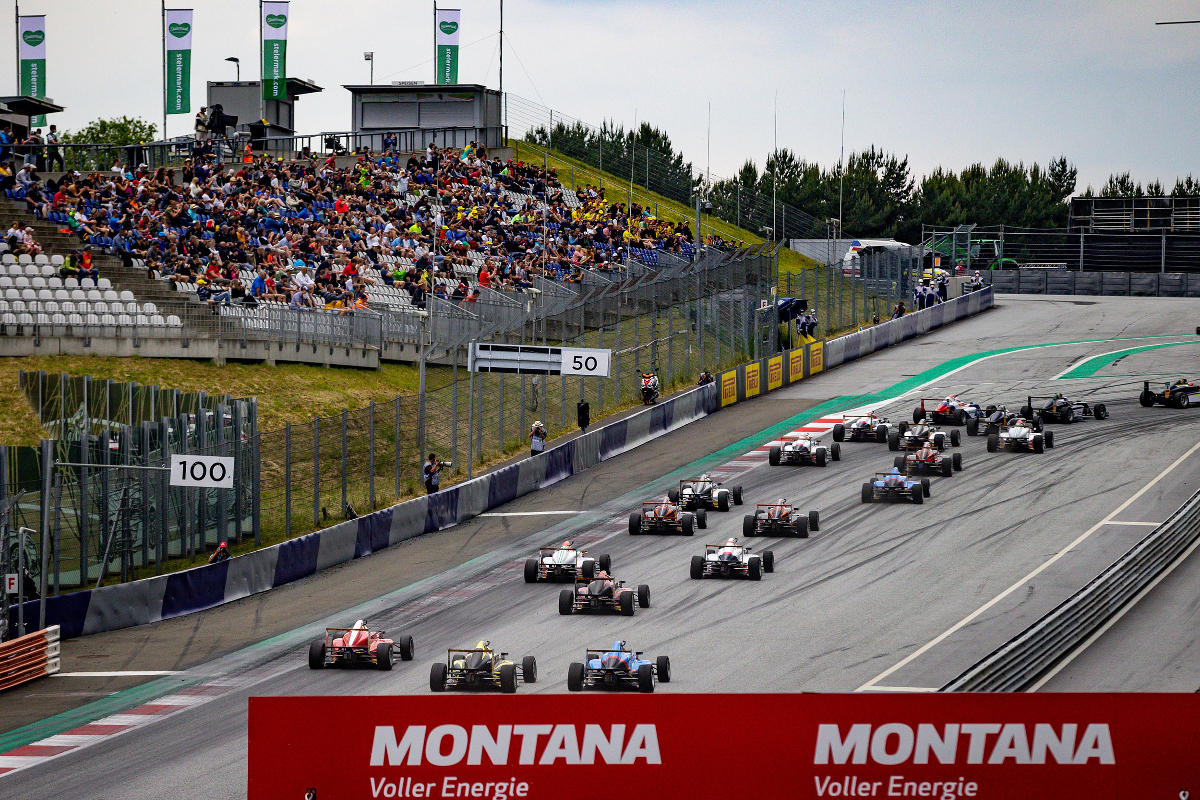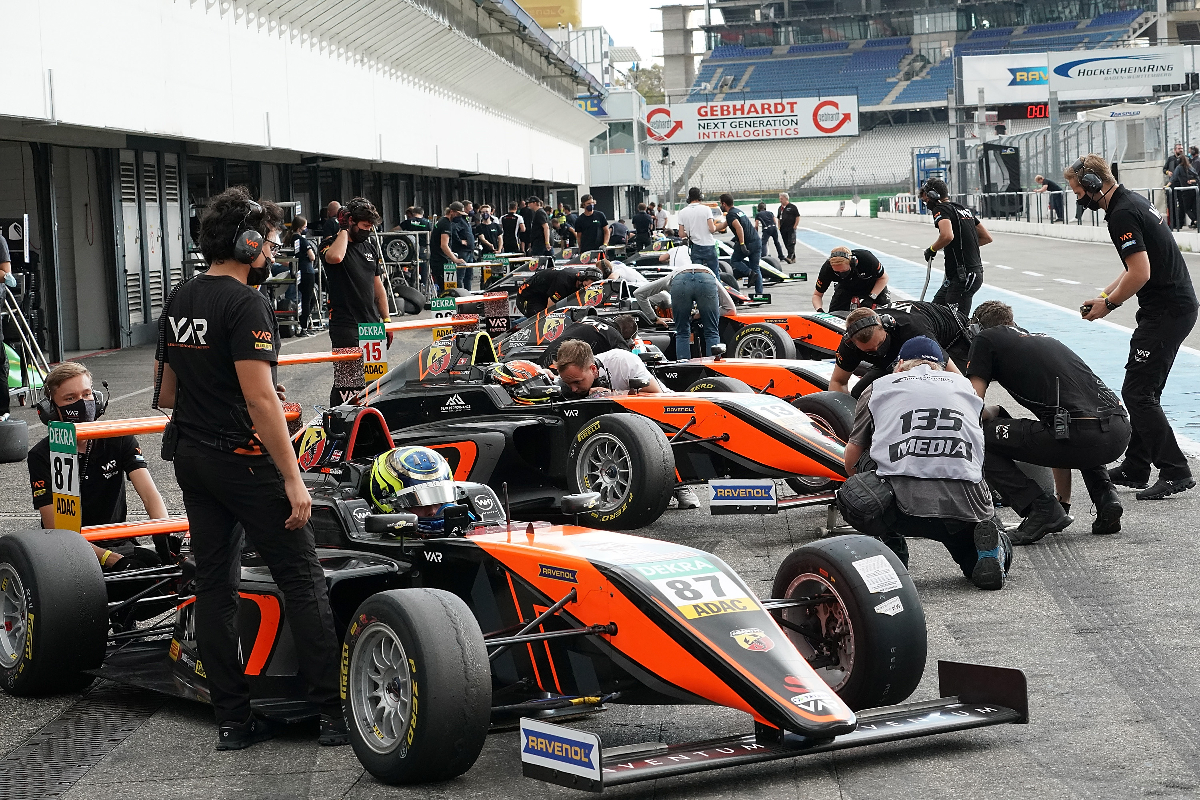
Photo: Roger Gascoigne
With just nine cars appearing at the Sachsenring for the fourth round of the ADAC Formula 4 season last weekend, the series reached a historical low point in depth, though not quality, of the grid
If you watched ADAC Formula 4 race one last Saturday, you would have seen a four-row grid line up and then race fairly frantically for the next half-hour. The story of the race, bar Tim Tramnitz’s swipe across Ollie Bearman at the start, was the fact that gearbox damage incurred in qualifying meant family-run team Sauter Engineering+Design didn’t take part.
Meanwhile at the same time in Spain there were 24 cars racing at Jerez, and a few days prior there had been 35 cars in Italian F4 testing at Monza. In fact several of those were ADAC runners who then opted to skip the trip back to Germany.
Two years ago there was 17 cars in ADAC’s Sachsenring round, with a peak of 25 drivers on the grid in a season where current Formula 2 frontrunner Theo Pourchaire fought new FIA Formula 3 champion Dennis Hauger for the title. It was a battle that concluded at the undulating Sachsenring, a track located in eastern Germany and best known for hosting MotoGP.
One round later, the 2020 season opener at the Lausitzring, attracted only 11 cars. That was a new low for the series, and worse than what ADAC F4’s predecessor ADAC Formel Masters dropped to in 2010 when 12 cars started race one of the final round at Oschersleben.
What has caused the fall in numbers in the German series, and is anything being done to reverse the decline while direct rival Italian F4 looks close to securing a 40-car grid for its Monza season finale?
There are undoubtedly several factors, starting with the calendar and the perennial issue of budgets. Series organiser ADAC sees a perfect storm of contributing factors that led to last weekend’s low turnout.
“Due to COVID-19, we haven’t been able to co-ordinate the calendar as closely with our Italian colleagues as in previous years, so we expected a more difficult year from the beginning” ADAC’s press officer Oliver Runschke told Formula Scout.

Photo: ADAC
As a result of the pandemic the season did not get going until mid-June following the postponement and then cancellation of the planned opening round at Oschersleben. Then the Nurburgring round had to be moved from August to November due to the flooding that hit the local area in summer.
Consequently, the season has ended up with four out of six rounds being held from mid-September to early November. At the same time, Italian F4 has already held five rounds and concludes with two events on home soil this month.
Gerhard Ungar, co-founder and team principal of the US Racing team that ran Pourchaire in 2019 and took a clean sweep of victories last weekend, believes that the logistical problems caused by such a tightly packed end to the season makes doing the usual double programme in ADAC and Italian F4 extremely challenging.
“Even without any direct calendar clashes with the Italian championship, the number of tests and races in quick succession is problematic,” he said. “This week there was a test on Tuesday and Wednesday at Monza but we needed to be here by Wednesday evening to begin setting up.”
Fastest in that test was BWR Motorsports’ Taylor Barnard. The newly created team only competes in ADAC F4, but Nico Rosberg protege Barnard told Formula Scout: “After the recent results we decided to do some additional testing as it would be more beneficial for the speed and us as a team.”
US Racing’s main rival Van Amersfoort Racing shares its concerns about the logistical problems in combining programmes.
“A double programme is really tough for the drivers but also for the teams, the engineers and the mechanics” said Rene Heesen, VAR’s F4 team manager, at the Sachsenring.
“We chose to skip the recent tests at Mugello and Monza, otherwise we wouldn’t have been able to make these races. At the end of the season it will come out whether that was the right decision or not, of course.”

Photo: ADAC
While VAR did make it, it was without Joshua Dufek and Bence Valint who were always due to miss an ADAC round or two and elected to skip last weekend’s. Instead Dufek and team-mate Cenyu Han joined rival teams in Italian F4 testing.
“Few drivers have the budgets for a completely double programme” Ungar added. He was without new signing Alex Dunne, who starred with two second places on his series debut in the previous round at Hockenheim.
“I only didn’t race at Sachsenring because I didn’t get an opportunity to test, but I will be back racing for the next rounds at Hockenheim and Nurburgring,” Dunne revealed post-weekend.
And that links to another reason for believing that last weekend was really a one-off, the circuit itself.
“The Sachsenring is a circuit that is unfortunately not particularly popular with the F4 teams,” said Runschke.
“There is no real opportunity for testing and the large gravel traps add to the challenge. For that reason, it is not an attractive circuit for the teams. We know that the teams and drivers would much prefer to race on grand prix circuits”.
This observation is borne out by the fact that the first two rounds of the revised 2021 calendar, held at current Formula 1 venues the Red Bull Ring and Zandvoort, attracted in excess of 20 cars. These included guest drivers from Jenzer Motorsport and Iron Lynx. Not without coincidence these are also the only rounds so far that Prema has contested. As the Red Bull Ring appears in the Italian calendar too, several teams visited in advance to gain track mileage in the Austrian F4 Cup.
Runschke is hopeful that Prema and Mucke Motorsport will appear at the next round to be held at Hockenheim on October 23/24, bringing the field back up to around 20 cars but “it is difficult to get a full field” he admits.
For a driver such as Barnard, as a rookie testing may be more beneficial than a race on an all-new circuit, the Sachsenring is maybe an obvious race to skip given that he would be unlikely to encounter it again higher up the single-seater ladder.

Photo: ADAC
However, adding grand prix circuits to the schedule is not as easy as it might seem. FIA regulations prohibit what is considered a national championship from running more than two “foreign” rounds, and the price of renting circuits is going up year-on-year for cash-starved F1 hosts.
“For us that means that we have the Sachsenring and Oschersleben alongside Hockenheim and the Nurburgring, whereas the Italians have their [non-F1 track] rounds at Misano and Vallelunga” said Runschke.
“It would be nice to be able to return to a circuit like Spa-Francorchamps, a grand prix circuit in a neighbouring country, but we need to discuss a possible waiver with the FIA first.”
Italy can boast two more recent grand prix circuits in Imola and Mugello alongside Monza to add glamour to the local part of its calendar. Does that mean that the ADAC series is now rather in the shadow of its Italian counterpart?
“Good question,” admitted Runschke. “In the past we used to have the same number of entries as Italy.”
Ungar, the only one of the teams running double programmes to prioritise the ADAC championship over the Italian one, was frank on his thoughts.
“In my opinion, the German championship is actually better organised than the Italian one and the professionalism of the platform is high,” he said.
Unsurprisingly, Runschke agrees that the ADAC is “not doing a bad job with the organisation” and “I do not believe that the costs of competing in Germany are different to Italy”. But with more F1 venues for your buck in the rival series, you can see the issue.

Photo: ACI Sport
Lastly, the shortage of German youngsters coming through the ranks does not help the championship gain entrants or media coverage in Germany. Of the nine drivers in action at the Sachsenring, only one, Tim Tramnitz, is German.
In Ungar’s view “there are a number of young German drivers in GT4 who should, I believe, be doing F4 as it remains the ideal place for young drivers to develop; they can then make the jump to GTs later”.
It is clear that the ADAC is looking to move partly away from the ADAC GT Masters support role for Germany’s premier single-seater championship, although adding more F1 tracks outside Germany will be difficult without that FIA waiver.
“We may end up with three rounds at Hockenheim again similar to 2018” admitted Runschke.
VAR’s Heesen is convinced the full double programme will be managable again with a more spread-out calendar, but that really depends on how quickly the post-pandemic world arrives.
Finally, there’s some big news coming at Hockenheim later this month. The expectation of the teams is that the series will continue with the Tatuus-Abarth combination for the halo-mounted second-generation cars. What is almost guaranteed is that the ADAC will not deviate from whatever ACI Sports decides for the Italian championship, and that news is expected by Formula Scout to arrive this week.
But this does leave the ADAC F4 championship in a stalled position – it clearly needs to run alongside the Italian series and use identical machinery to allow teams to maximise the return on their investment but without the schedule becoming so crowded that logistically it is impossible to combine the programmes.